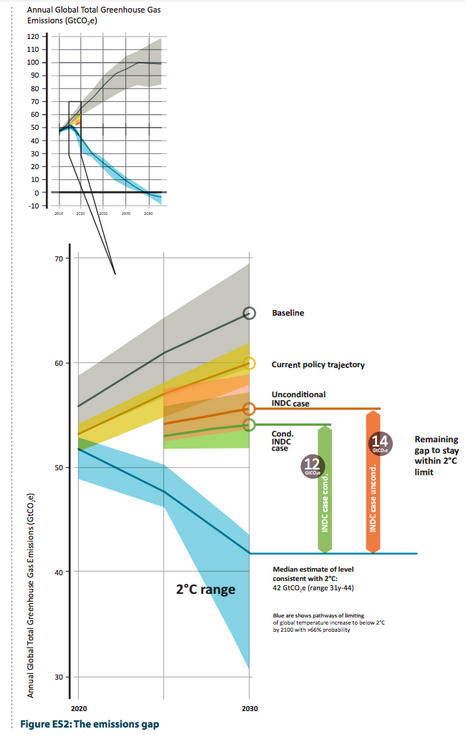Look beyond emissions gap to see full force of climate pledges, says UNEP report
Simon Evans
11.06.15Simon Evans
06.11.2015 | 8:31amClimate pledges submitted to the UN reduce the emissions gap between current action and what is needed to avoid dangerous climate change, with social and political effects that reach far beyond their impact on aggregate emissions.
That’s the optimistic conclusion of the latest UN Environment Programme (UNEP) Emissions Gap Report, published this morning. Nevertheless, it confirms that the collective ambition of Intended Nationally Determined Contributions (INDCs) is “far from enough”, leaving a “very significant” emissions gap in 2030.
The analysis comes just a week after a similar report from the UN climate body the UNFCCC, which aggregated the impact of the 119 INDCs submitted by 1 October.
While many of the conclusions are similar, today’s UNEP report goes beyond a simple adding up pledges and considers the wider impacts of the INDCs, as well as options for closing the emissions gap through enhanced action, sub-national initiatives and efforts to reduce deforestation.
Bending the curve
Like last week’s report, UNEP concludes that the INDCs represent a real increase in ambition, compared to the policies in place before the pledges were made.
Some of the INDCs include both conditional and unconditional elements. However, even if fully implemented, the INDCs would leave emissions on an upwards trajectory in 2030, UNEP says.
![]()
A gap of 12-14 gigatonnes of CO2 equivalent remains between emissions in 2030 and the cost-effective path to staying below 2C, it concludes. The 2C limit is the internationally agreed goal for avoiding the worst effects of climate change.
All these points are illustrated on the UNEP graphic, below. The baseline scenario shows what might have happened to emissions if no new climate policies had been implemented after 2010. Current policies means what was in place before any INDCs were submitted in March.
The path of emissions between 2020 and 2030 under baseline policies, policies already in place today and with unconditional or conditional climate pledges added. The 2C range shows the cost-effective path to limiting warming. Source: UNEP Emissions Gap Report 2015.
Wider effects
The chart illustrates why UNEP says current pledges are “far from enough”, leaving an emissions gap in 2030 that “will be very significant”. It says the INDCs, if fully implemented, would put the world on track for warming of around 3-3.5C by the end of the century.
Though this initially seems at odds with the 2.7C of warming by 2100 expected by the UNFCCC report, the difference comes down to how confident we can be in staying below those thresholds. Carbon Brief explored these differences in more depth last week.
So, there’s broad agreement — and, in fact, there has been for well over a year — that the aggregate impact of climate pledges in advance of Paris will fall short of securing the below-2C goal.
What’s interesting about the emissions gap report, however, is that UNEP seems keen to emphasise the indirect, positive impacts of the INDCs.
The reports says:
The social and political effects of the INDCs and the processes undertaken at national level transcend the aggregate effect they are estimated to have on total global greenhouse gas emission levels in 2025 and 2030. The preparation of the INDCs has in many countries incentivized exploration of linkages between development and climate, as well as development of new national climate policies, and can be seen as an important step in a transition towards low carbon economies.
Closing the gap
UNEP’s report also explores the ways the emissions gap could be closed through enhanced action. This will be important because, like the UNFCCC report, it says that delaying greater efforts until after 2030 will make it more costly, and maybe even impossible, to avoid dangerous warming.
A range of proven technologies and policies can close almost all of the gap, UNEP says, giving a particular emphasis to energy efficiency in buildings, industry and transport.
Sub-national action such as the C40 Cities initiative “can potentially be significant” in closing the gap, the report adds. Though it can be hard to assess if these efforts are truly additional to national action, UNEP says the evidence suggests 30-66% of their reductions could be additional.
In aggregate, it says, sub-national action could contribute additional reductions of up to 2GtCO2e in 2020. The evidence on their impact in 2030 is too limited to assess, however.
Finally, the emissions gap report looks at the potential from reducing emissions from deforestation and forest degradation, known as REDD+. While this has a large theoretical potential of 9GtCO2e in 2030, UNEP says this will be “significantly constrained by economic and land-use factors”.
Conclusion
The 2015 emissions gap report will not be the last word on the impact of climate pledges submitted this year, in advance of the Paris summit in December. For starters, UNEP will update its analysis on the eve of Paris, to take account of any late INDC submissions.
Today’s report considers only the 119 submissions made by 1 October. If the remaining parties yet to make a contribution were to make efforts in line with everyone else — and this is a big if — then the 2030 emissions gap would close by between 0.5 and 1GtCO2e. None of this is enough to avoid 2C, but it is a start.



